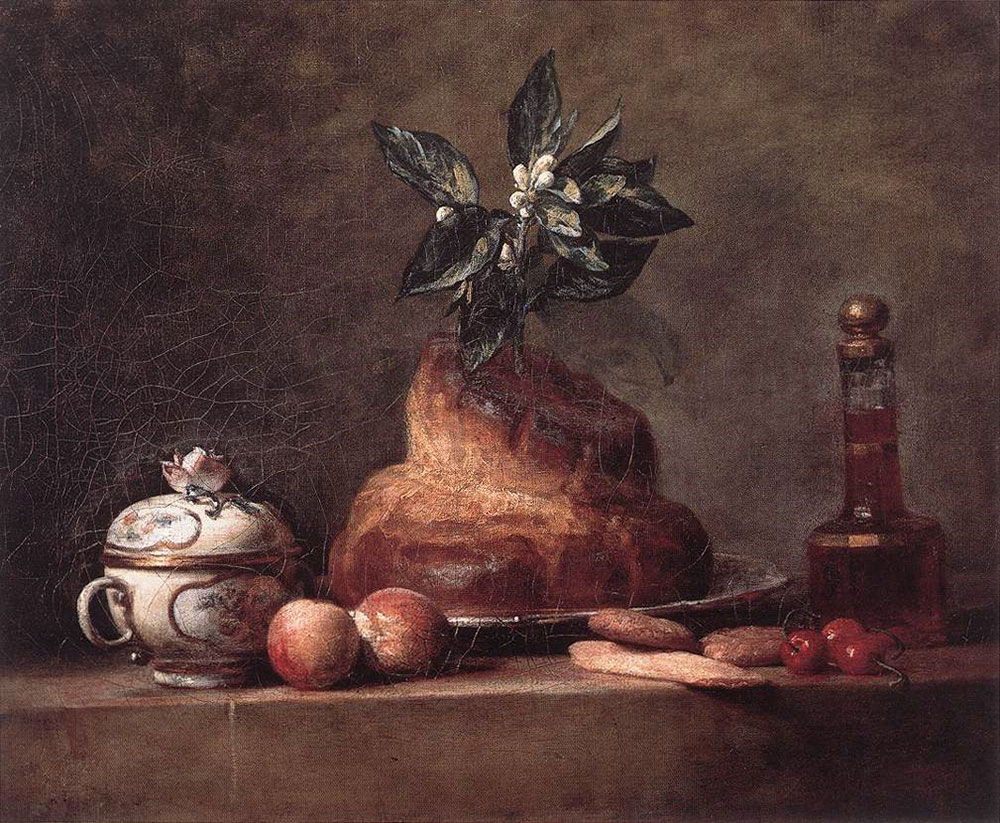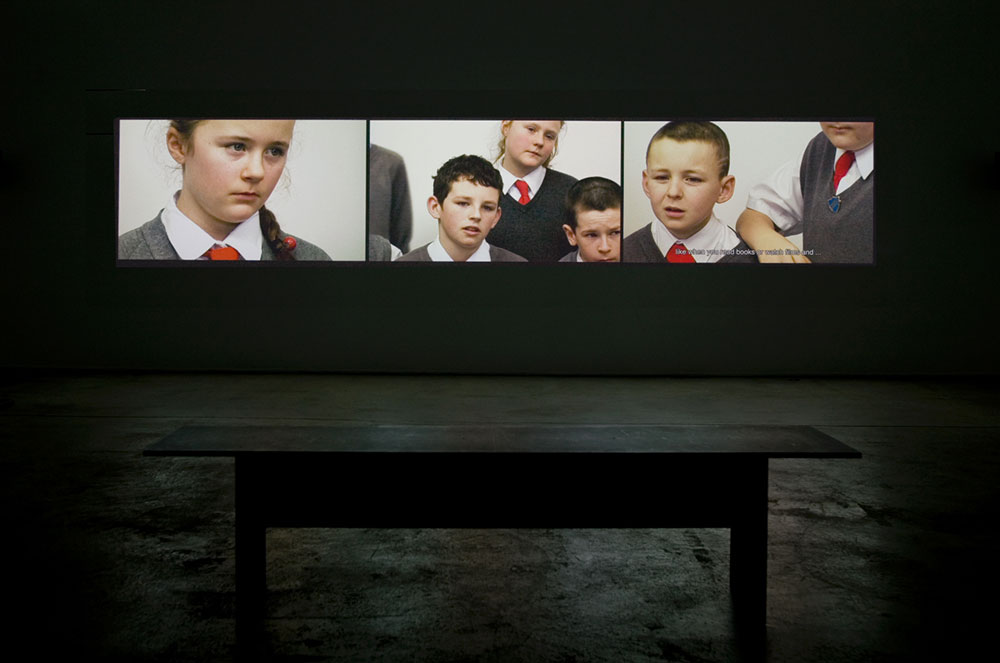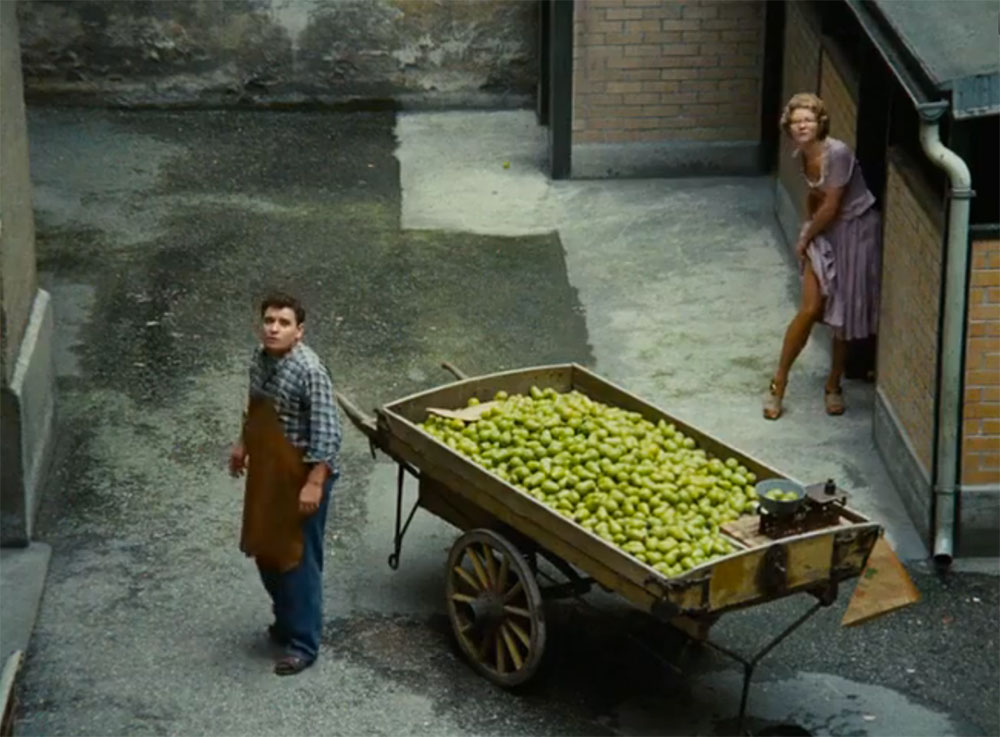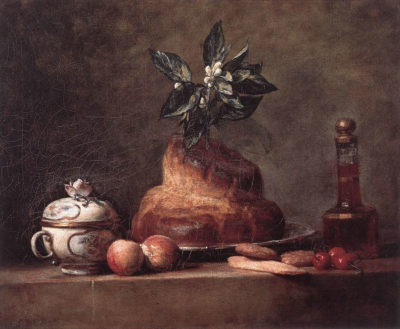Seeing First and Then Still: Art Historians and Objects
Naomi Vogt
To cite this contribution:
Vogt, Naomi. ‘Seeing First and Then Still: Art Historians and Objects.’ OAR: The Oxford Artistic and Practice Based Research Platform Issue 0 (2016), http://www.oarplatform.com/seeing-first-and-then-still-art-historians-and-objects/.

Jean-Baptiste-Siméon Chardin, La brioche, 1763, oil on canvas, 47 × 56 cm, Musée du Louvre, Paris.
Marcel Duchamp opportunely wrote on one of the scattered pieces of paper in his work La boîte de 1914 that, while one cannot ‘listen to hearing’ (écouter entendre), one is able to ‘look at seeing’ (regarder voir). Sight allows for the perception of itself in action as it occurs through another being. It is otherwise equally impossible to taste someone tasting or to smell someone smelling. Through touch, one may be able to feel objects and the bodies of others encountering each other, but in order to touch someone touching (that is to feel, through touch, what someone feels and to feel them feeling it), one would need to touch the very point of contact, thus interrupting it.1
The empirical practice of looking at others look does not expressly make up a central part of art history and theory as a discipline. Yet attending to the content and disposition of optical perceptions, as a mode of inquiry, is an essential feature of any study in visual culture. This attention to the way objects may look to others and to the researchers themselves tends to constitute a preliminary stage in art historical inquiry, usually followed by investigations regarded as more contextual and theoretical. The communication of the content and disposition of these preliminary visual observations in verbal form is then carried out through ekphrasis. From the Greek word that translates literally as ‘that which is spoken out’, ekphrasis today almost always refers to the description of artworks or images. This practice is paradigmatic of the discipline and contributes to the fact that the ‘representational regime of writing’, as Adrian Rifkin calls it, has held captive even the most radical, socially critical histories of art.2
Rineke Dijkstra’s triptych video installation I See a Woman Crying (2009) is a device for ‘looking at seeing’, in which the object of the protagonists’ gaze is present only in words. The viewer is confronted with the faces of schoolchildren performing ekphrases. In front of them hangs Pablo Picasso’s 1937 work La femme qui pleure (Weeping Woman). The painting is never filmed but surfaces through candid descriptions, ranging from concise accounts of color to tentative, compassionate interpretations, such as: ‘Maybe she’s crying because she was at a wedding and she stole the cake’. In Dijkstra’s work, seeing is thus prolonged and fully interspersed with the act of analyzing. The earliest record of purposeful art description, Philostratus’s Imagines (second-century BCE), similarly depicts a child, seemingly an exemplar of ingenuous beholding and recounting. In the opening sentences, Scamander asks a boy whether he perhaps failed to notice that the painting facing him is based on Homer, precisely because he was instead ‘lost in wonder as to how in the world the fire could live in the midst of water’.3 Scamander subsequently urges the boy to turn his eyes away from the image in order to concentrate on its meaning. And it sometimes seems as though art history as a whole could be apprehended as successive acts of perusing and looking away so as to transform visual matter into meaning – ‘meaning’ being usually considered a subsequent and ultimate stage, and one that by definition must materialize verbally.
Ekphrasis presupposes inter-mediality – the transition from a visual and material realm to that of ‘immaterial’ thoughts and words. The process further implies a temporal alteration, given that the senses grasp the appearance and content of most art in a non-sequential way (and time-based works only partially contradict this fact), whereas spoken and written theory aims to unfold in a prescriptive order. This also means that unadulterated content in intermedia transpositions is impossible. Erwin Panofsky, the art historian who coined ‘pre-iconographical description’, the ideal first stage in visual analysis made of purely formal accounts, was also the one to warn us against its impracticability: because all descriptions automatically renegotiate shapes into symbols.4 It is difficult to qualify a limb in a picture without, at some early point, naming it, and it is hard to describe its color without gesturing towards the notion of skin. Not to mention that the transition from image to word is accompanied by equally substantial conversions from words into other words. Art historians study books as much as, if not more than, they study visual objects, to such an extent that these objects become almost inseparable from their semantic and theoretical baggage.
Sometimes the ekphrasis is made precisely to exist without the object. It can then act as a series of formula to produce the object as if by magic. ‘By the window, place a full glass of wine, a bottle, a started loaf of bread […] and you shall see Chardin’s canvas’,5 wrote Denis Diderot for his remote readership, who would most likely never see the still life with their own eyes. Here the author tries to make the legible visible, whereas the ambition of art history (at least since the widespread use of reproductions, and since the legacy of father figure Johann Joachim Winckelmann) has broadly been to make the visible legible. Unlike the objects of many other disciplines, such as ecosystems, historical events, or psychological triggers, the visual objects studied by art history tend to subsist physically, often integrally alongside the research, in addition to being made widely available through reproductions. This factor could intimate to researchers that their role is essentially to magnify the already auspicious presence of the object, by allowing the reader to ‘see more than they saw before’.6 By the same token, this presence can create a complex in the minds of the researchers, who may feel at a constant, almost pleonastic second remove from their subject-matter. Jaś Elsner vexes this complex when he declares that art history ‘is nothing other than ekphrasis’,7 before offering some relief with an appreciative comparison according to which theorists’ ekphrastic appropriations are after all ‘not much different from Michelangelo’s own appropriation of a block of Carrara marble’.8

Rineke Dijkstra, I See a Woman Crying (Weeping Woman), 2009 – 2010, three-channel HD video (color, sound), 12 min, courtesy of the artist and Marian Goodman Gallery, New York.
If art can be carved by theory like marble is sculpted by artists, the practice of art history raises doubt about the primacy of the object, or rather about the primacy of looking at it. In Zadie Smith’s novel On Beauty, Howard, a post-modernist art historian bent on deconstructing the myth of genius, has undertaken to write his own masterpiece: Against Rembrandt. At the end of the story, standing in front of his class, he is struck mute by a painting, which he begins to project larger and larger onto the wall. ‘“Hendrickje Bathing, 1654,” croaked Howard and said no more’.9 Here, seeing only took place after a long and relentless ekphrasis, a situation deplored by Elsner and others, whereby the doctrine fuelling the descriptions mistakenly serves as the starting point, where the objects should be.
In that case, the communication of any kind of knowledge based on partly visual observations can qualify as ekphrasis, regardless of the discipline framing it. Anthropologist David Zeitlyn recently argued for instance that all accounts in the social sciences are ekphrastic in that they are ‘translations across media’: from the field to a theoretical piece of writing that aims to represent ‘content’ from the field.10 This recognition is essential to asserting the importance of description and image-making in research across the disciplines. Art history itself makes images, and not only in the sense that it transfigures pre-existing, material ones. But these considerations, which amount to ‘looking at seeing’, and this attendance to the construction of knowledge through description also create a strong binary between fieldwork or visual observations and the making of meaning. As if seeing were the practice that happened first, and meaning that which followed – as with Scamander and the boy, after having looked away. But in research, seeing unfolds together with other forms of witnessing and engaging. The assumption that these practices constitute only a preliminary stage, and one aimed solely at data collection, has a corollary (at least in the humanities): the fact that art and artefacts are treated as products of history much more than they are considered social and material agents in the world.
Thus, the description of these objects regularly concentrates on how they look and why they came to be. Because art itself tends to be held as a descriptive category of objects (whether descriptive of events, feelings, appearances, or ideas), a Droste effect crystallizes when art history becomes a description of descriptive material. It is based on this premise that 17th century Dutch painting, for instance, has been correlated to an ethnography of the society it depicted. But construing art as an index of the context that produced it inhibits other modes of engagement with it. As Tim Ingold suggests, if we want to use the metaphor of art as a document of being into the world, it is better to skip the image of ‘ethnography as description’ in order to favour the image of ‘anthropology as inquiry’.11 If art, like anthropology, is an inquiry into humans’ experience of being in the world, then art history can inquire into what art does and did – instead of representing what it represented and testifies to. Surely, several art histories already do precisely that, from Hans Belting and Alexander Nagel’s renderings of images rooted in their effective pre-Renaissance roles, to Marc Ferro’s insistence on the historical agency of moving images. However, the boundary between such kinds of research and ekphrasis is perhaps less bold than it appears – given that, in each case, one must account for the perception of an object.
In Adrian Rifkin’s performance lecture ‘On Writing the Last Line First’, further boundaries are productively blurred. Not only the boundaries between practice and theory or between pedagogy and performance, but also those between seeing and evoking, and between collecting data and making meaning. Rifkin’s intervention is based on a series of cultural and material objects, from M&M’s and the concept of the Archive to a 1953 song by Pierre Mac Orlan, theatre played in provincial hippodromes, the protean figure of Tinker Bell, and films made by Ernst Lubitsch, Rainer Werner Fassbinder, Vanalyne Green, and Jean-Luc Godard. Throughout the intervention, Rifkin undertakes to at once describe and simulate these pieces of visual culture, which he has been collecting for years, in order, he says, to let them speak in his place. These objects are the ‘shock’ moments, mainly in films, that make one gasp because they are so swift, so ‘really and verbally perfect’ that once they have happened you can never truly wrap your mind around what they were. ‘Frische Birnen! Frische Birnen!’ (‘Fresh pears! Fresh pears!’) he says, like Hans the fruit monger in the opening scenes of Fassbinder’s Händler der vier Jahreszeiten (The Merchant of Four Seasons, 1971). Yet Rifkin is not merely imitating the protagonist; he is executing the filmic scene itself. As he slowly twists his upper body to the right, he looks as though he is about to lift his skirt, as Hans’s wife does when she emerges from a door and a woman catches sight of them from her courtyard window, briefly suspending this ‘perfect’ ‘shock’ moment. Rifkin adds that he wishes he could have been that filmic scene, had he ever found himself in that moment or position of enunciation – a moment and position which, indeed, he has just produced within his performance.

Rainer Werner Fassbinder, Händler der vier Jahreszeiten, 1971, 88 min, West Germany: Tangofilm Produktion, screen capture.
In Rifkin’s intervention, the act of seeing (both for the researcher and his audience) is thus prolonged and integrated with all the conclusions that are potentially, simultaneously being drawn through discourse. The members of the audience become accomplices; they are made complicit with the content and meanings brought about in the talk. A better way to explain this would be to say that the elicited objects and scenes were being interpreted live – interpreted not in the sense of an analysis or a translation, but almost in the sense meant when we say that a musician interprets sheet music. This kind of interpretation actualizes material that is already somehow present – like a musician actualizes the sounds contained in a score. Imaginary characters, moving images, and art objects too can be interpreted in this way, by being at once actualized or made visible, and treated as agents in the world. Seeing and making meaning can then become innately concurrent.

Jean-Baptiste-Siméon Chardin, La brioche, 1763, oil on canvas, 47 × 56 cm, Musée du Louvre, Paris.
1. This point may certainly be complicated to greater extents, notably by attending to the disagreements between Jean-Paul Sartre and Maurice Merleau-Ponty regarding forms of perception, and the latter’s contention that touching and being touched can never fully coincide.
2. Adrian Rifkin, Inter-disciplinary Encounters: Hidden and Visible Explorations of the Work of Adrian Rifkin (London : I.B. Tauris & Co, 2015), 9.
3. Philostratus, Imagines (Cambridge: Harvard University Press, 2014), 7.
4. Erwin Panofsky, ‘On the Problem of Describing and Interpreting Works of Art,’ Critical Inquiry 38 (2012): 469.
5. Denis Diderot, ‘Salon de 1765,’ in Oeuvres de Denis Diderot (Paris: J.L.G Brière, 1821), 85.
6. Jaś Elsner, ‘Art History as Ekphrasis,’ Art History 33 (2010): 26.
7. Ibid., 11.
8. Ibid., 23.
9. Zadie Smith, On Beauty (New York: Penguin, 2006), 442.
10. David Zeitlyn, ‘Antinomies of Representation: Anthropology as an Ekphrastic Process,’ HAU: Journal of Ethnographic Theory 4:3 (2014): 342.
11. Tim Ingold, ‘Ethnography is to Anthropology as Art History is to Art Practice: A Provocation’, Frank Davis Memorial Lecture Series: Anthropology and Art History, The Courtauld Institute of Art, 10 November 2015.
About the author:
Naomi Vogt is a doctoral researcher at the Ruskin School of Art, University of Oxford, and a SNSF fellow. Her research engages with the representation and invention of ritual in recent film and video practices. Previous research, published in Third Text, addressed the notion of moving image as monument. She received degrees in archaeology and art history from Oxford and the Sorbonne, and is a co-founder and editor of OAR.
